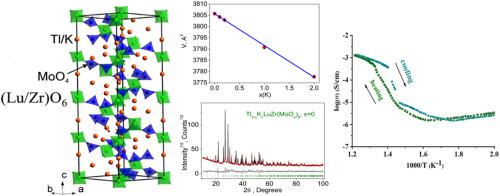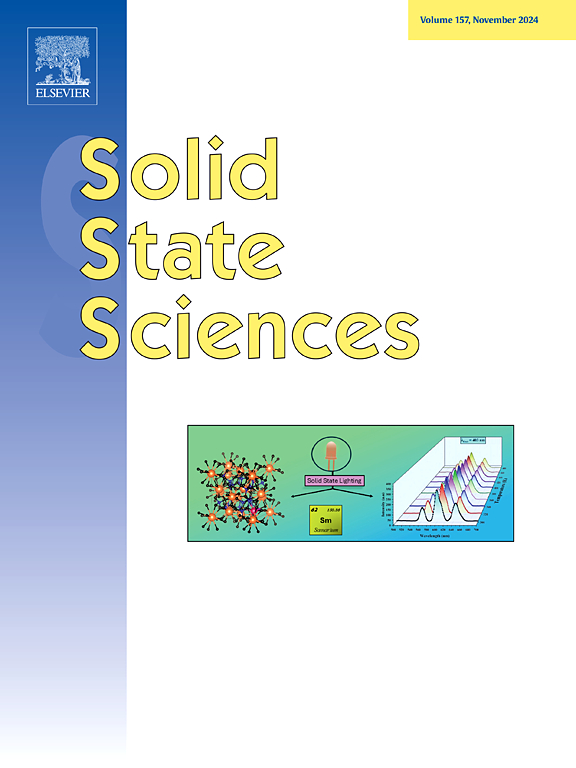Synthesis and investigation of the structure, thermal and electrical properties of new Tl5-xKxLuZr(MoO4)6 (x = 0; 0.1; 0.2; 1; 2) molybdates
IF 3.4
3区 化学
Q2 CHEMISTRY, INORGANIC & NUCLEAR
引用次数: 0
Abstract
The traditional solid-state synthesizing method was employed to prepare Tl5-xKxLuZr(MoO4)6 (x = 0; 0.1; 0.2; 1; 2) ceramics. Structural characterization was performed through the Rietveld method on the X-ray powder diffraction data. The unit cell parameters are defined for Tl5-xKxLuZr(MoO4)6 (x = 0; 0.1; 0.2; 1; 2). Impedance spectra were measured at temperatures ranging from 300 to 800 K, covering a frequency range of 1 Hz to 1 MHz. The results show that the electrical conductivity decreases with an incrementing in the x value in the range of x = 0.1–2.0. Tl4.9K0.1LuZr(MoO4)6 has the best ionic conductivity of this series of molybdates (1.31 × 10−3 S cm−1), and Tl5LuZr(MoO4)6 has the lowest conductivity (5.51 × 10−4 S cm−1). Activation energy was found out to decrease from 1.32 eV for Tl5LuZr(MoO4)6 to 0.92 eV for Tl4.9K0.1LuZr(MoO4)6.

新型 Tl5-xKxLuZr(MoO4)6 (x = 0; 0.1; 0.2; 1; 2) 钼酸盐的合成及其结构、热学和电学特性研究
采用传统固态合成法制备了 Tl5-xKxLuZr(MoO4)6 (x = 0; 0.1; 0.2; 1; 2) 陶瓷。通过对 X 射线粉末衍射数据的里特维尔德法进行了结构表征。确定了 Tl5-xKxLuZr(MoO4)6 (x = 0; 0.1; 0.2; 1; 2) 的单胞参数。在 300 至 800 K 的温度范围内测量了阻抗谱,频率范围为 1 Hz 至 1 MHz。结果表明,在 x = 0.1-2.0 的范围内,电导率随着 x 值的增加而降低。在这一系列钼酸盐中,Tl4.9K0.1LuZr(MoO4)6 的离子导电率最好(1.31 × 10-3 S cm-1),而 Tl5LuZr(MoO4)6 的导电率最低(5.51 × 10-4 S cm-1)。活化能从 Tl5LuZr(MoO4)6 的 1.32 eV 下降到 Tl4.9K0.1LuZr(MoO4)6 的 0.92 eV。
本文章由计算机程序翻译,如有差异,请以英文原文为准。
求助全文
约1分钟内获得全文
求助全文
来源期刊

Solid State Sciences
化学-无机化学与核化学
CiteScore
6.60
自引率
2.90%
发文量
214
审稿时长
27 days
期刊介绍:
Solid State Sciences is the journal for researchers from the broad solid state chemistry and physics community. It publishes key articles on all aspects of solid state synthesis, structure-property relationships, theory and functionalities, in relation with experiments.
Key topics for stand-alone papers and special issues:
-Novel ways of synthesis, inorganic functional materials, including porous and glassy materials, hybrid organic-inorganic compounds and nanomaterials
-Physical properties, emphasizing but not limited to the electrical, magnetical and optical features
-Materials related to information technology and energy and environmental sciences.
The journal publishes feature articles from experts in the field upon invitation.
Solid State Sciences - your gateway to energy-related materials.
 求助内容:
求助内容: 应助结果提醒方式:
应助结果提醒方式:


